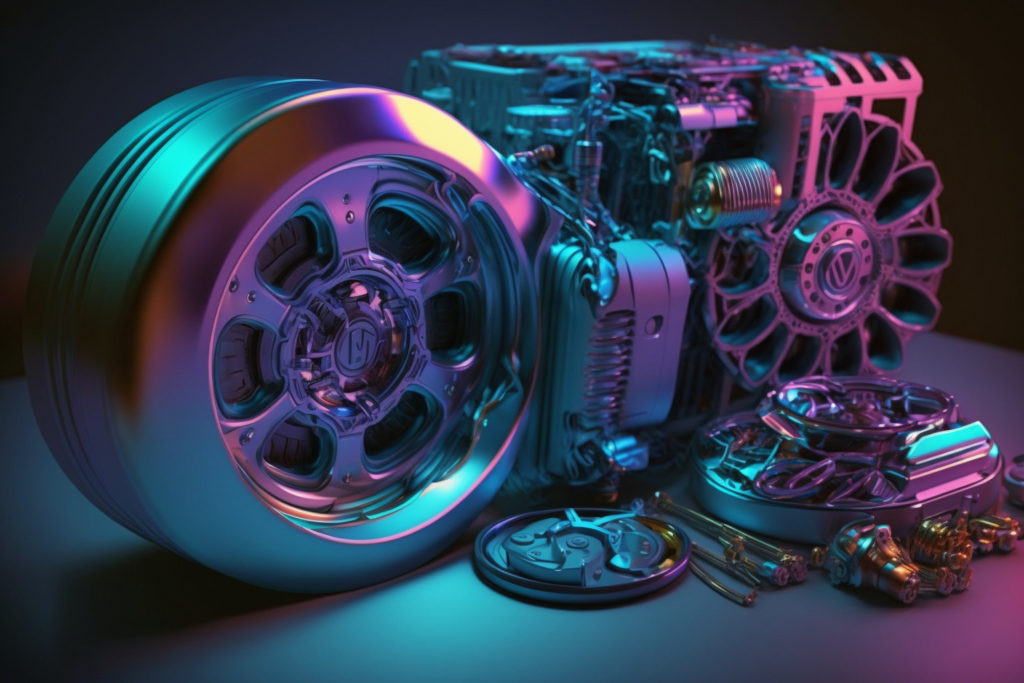I. Introduction
The automotive parts industry has experienced significant growth in recent years, driven by increasing demand for car parts, automotive components, and spare parts. As vehicles become more advanced and consumers demand higher quality and performance, the need for reliable and innovative components grows. In this guide, we will delve into the world of car parts, discussing market trends, major players, and the future outlook for this thriving industry. This guide is designed for market researchers and investors who are interested in understanding the dynamics of the automotive parts sector and making informed decisions.
Over the past decade, the global automotive parts market has experienced a compound annual growth rate (CAGR) of approximately 4.4% (source), with projections showing even more growth in the coming years. This expansion can be attributed to several factors, including the increasing number of vehicles on the road, technological advancements in automotive components, and a growing focus on vehicle safety and emissions regulations.
As the market evolves, opportunities are emerging for Original Equipment Manufacturers (OEMs) and aftermarket parts suppliers to capitalize on the increasing demand for high-quality car parts. Major players in the industry, such as Bosch, DENSO, and Continental, have already made significant investments in research and development to produce cutting-edge automotive components that cater to the needs of today’s consumers.
EVs and New Technologies
One key trend in the automotive parts industry is the growing importance of electric vehicles (EVs). As governments around the world implement stricter emissions regulations, automakers are racing to develop electric and hybrid vehicles. This shift has led to increased demand for specialized components, such as batteries, electric motors, and charging systems, creating opportunities for parts suppliers to expand their product offerings and tap into new markets. For example, LG Chem and CATL have emerged as dominant players in the EV battery market, thanks to their advanced technologies and strong partnerships with leading automakers.
In addition to electric vehicle components, the automotive parts industry is also witnessing a surge in demand for advanced driver assistance systems (ADAS) and autonomous driving technologies. Companies like Mobileye and NVIDIA are at the forefront of these developments, supplying automakers with cutting-edge sensors, cameras, and software that enable features such as adaptive cruise control, lane keeping assistance, and self-parking capabilities.
In conclusion, the automotive parts industry is poised for continued growth, driven by innovations in technology and an increasing focus on sustainability and safety. By staying informed about market trends and the latest developments, market researchers and investors can capitalize on the opportunities presented by this dynamic sector.

II. Types and Classification of Car Parts and Components
A. Mechanical Parts
Mechanical parts are the backbone of any vehicle, providing the necessary power and functionality to keep it running smoothly. The following sections outline key mechanical components found in modern vehicles.
- Engine components: The engine is the heart of a vehicle, converting fuel into mechanical energy to power the car. Key engine components include the cylinder block, pistons, turbochargers, and fuel injectors. Major suppliers in the engine components market include MAHLE and Federal-Mogul.
- Transmission parts: The transmission system transfers power from the engine to the wheels, ensuring the vehicle moves at the desired speed. Critical transmission components consist of the gearbox, clutch, and drivetrain. Notable transmission parts manufacturers include ZF Group and Eaton Corporation.
- Suspension and steering components: Suspension and steering systems ensure a smooth and comfortable ride while maintaining vehicle stability and handling. Key components include struts, shock absorbers, and tie rods. Leading suppliers in this sector are KYB Corporation and Tenneco.
B. Electrical Parts
Modern vehicles rely heavily on electrical parts for various functions, from starting the engine to controlling in-car infotainment systems. Some key categories of electrical components in vehicles include:
- Battery and charging system components: The battery is the heart of a vehicle’s electrical system, providing power for starting the engine and running electrical devices. Key components include the alternator, which generates electricity to recharge the battery, and the starter motor, which helps crank the engine. Leading manufacturers of automotive batteries include Johnson Controls and Exide Technologies.
- Ignition and starting system parts: These components are responsible for igniting the fuel-air mixture in the engine and maintaining combustion. Key parts include the ignition coil, which transforms the battery’s voltage into a higher voltage, and the spark plugs, which ignite the fuel mixture. Major suppliers of ignition system components include NGK and BorgWarner.
- Lighting and instrumentation components: These parts help drivers monitor vehicle performance and ensure visibility in various driving conditions. Key components include headlights, taillights, and instrument panel gauges. Leading manufacturers of automotive lighting solutions include Hella and Magneti Marelli.
C. Body and Interior Parts
The aesthetic appeal and functionality of a vehicle largely depend on the quality of its body and interior parts. Here are some key categories of these components:
- Exterior body parts: These components contribute to a vehicle’s aerodynamics, aesthetics, and structural integrity. Key parts include the hood, fenders, doors, and bumpers. Major suppliers of exterior body parts include Faurecia and Magna International.
- Interior components and accessories: These parts contribute to the comfort, functionality, and safety of a vehicle’s cabin. Key components include seats, airbags, and infotainment systems. Leading manufacturers of automotive interior components include Lear Corporation and Adient.
D. Popular Car Parts and Components
In this section, we will explore specific examples of car parts, automotive components, and car spare parts that have gained prominence in the market due to their crucial role in vehicle performance and safety. We will also provide quantitative data to illustrate the growing demand for these components.
- Turbochargers: Turbochargers are a popular automotive component that enhances engine performance by increasing the air intake, which results in improved combustion and higher output. The global turbocharger market was valued at $24.6 billion in 2022 and is expected to grow at a CAGR of 7.6% from 2021 to 2028 (source). Well-known turbocharger manufacturers include Garrett Motion, BorgWarner, and Mitsubishi Heavy Industries.
- Advanced Driver Assistance Systems (ADAS): As mentioned earlier, ADAS is a rapidly growing segment in the automotive industry, with technologies like adaptive cruise control, lane departure warning systems, and automatic emergency braking. The global ADAS market was valued at $29.07 billion in 2022 and is projected to reach $83.83 billion by 2027, growing at a CAGR of 21.9% during the forecast period (source). Key players in this market include Aptiv, Bosch, and ZF Friedrichshafen.
- Lithium-ion Batteries: With the rise of electric vehicles, lithium-ion batteries have become an essential car component. The global lithium-ion battery market size was $36.7 billion in 2019 and is projected to reach $129.3 billion by 2027, growing at a CAGR of 18.0% from 2020 to 2027 (source). Major manufacturers in this market include Tesla, Panasonic, and Samsung SDI.
- Automotive Sensors: Sensors play a critical role in modern vehicles, with applications ranging from engine management to safety systems. The global automotive sensors market was valued at $24.0 billion in 2022.

III. The Global Automotive Parts Market
A. Key Market Drivers and Trends
The automotive parts market is fueled by various factors, such as an increase in the number of vehicles on the road, advancements in car components, and the growing demand for car spare parts. Additionally, there has been a rising focus on vehicle safety and compliance with emissions regulations. For instance, the introduction of the Euro 6 emissions standards in Europe has led to the development of cleaner and more efficient engines, boosting the market for advanced automotive parts.
B. Major Players in the Automotive Parts Industry
Various companies are shaping the automotive parts sector, with OEMs and aftermarket parts suppliers being the most significant contributors. Renowned OEMs include Bosch, DENSO, and Continental, which invest heavily in R&D to produce high-quality car parts and innovative car components. Aftermarket parts suppliers, like Magna and Federal-Mogul, provide cost-effective alternatives for vehicle owners seeking replacement automotive parts without compromising quality. Additionally, automotive retailers and distributors, such as AutoZone and Advance Auto Parts, play a crucial role in connecting consumers with both OEM and aftermarket products, catering to a wide array of needs and preferences.
C. Market Size, Growth, and Regional Analysis
The global automotive parts market has witnessed considerable growth in recent years, reaching a value of $1.5 trillion in 2021 (source). The market’s compound annual growth rate (CAGR) is projected to be around 4.0% from 2021 to 2028, driven by factors such as technological advancements, increasing vehicle ownership, and evolving consumer preferences for car parts and car components.
1. North America: The North American market for automotive parts is expected to experience steady growth, with the United States being a major contributor. A significant factor driving this growth is the region’s robust automotive industry, which includes major automakers like General Motors, Ford, and FCA. Moreover, the increasing popularity of electric vehicles and the rise of autonomous driving technology are expected to spur demand for advanced car components and car spare parts in the region.
2. Europe: Europe’s automotive parts market is driven by a strong automotive manufacturing base, with leading automakers like Volkswagen, BMW, and Daimler headquartered in the region. Additionally, stringent environmental regulations, such as the aforementioned Euro 6 emissions standards, have led to increased demand for eco-friendly car parts and automotive components. Furthermore, the European market has seen significant growth in the electric vehicle (EV) segment, with countries like Norway and the Netherlands leading the way in EV adoption (source).
3. Asia-Pacific: The Asia-Pacific region is expected to witness the fastest growth in the automotive parts market, with a projected CAGR of 5.3% from 2021 to 2028 (source). This growth can be attributed to the expanding automotive industry in countries like China, India, and Japan.
4. Latin America: The Latin American automotive parts market has been experiencing steady growth, with countries like Brazil, Argentina, and Mexico driving demand for car parts, automotive components, and car spare parts. In 2022, the Latin American automotive parts market was valued at approximately USD 66.8 billion (source), with projections indicating continued expansion in the coming years. This growth is fueled by factors such as rising vehicle ownership, increasing consumer spending, and the expanding automotive manufacturing sector in the region.
One notable trend in the Latin American market is the growing importance of electric vehicles and their corresponding components. Governments in the region, such as Chile and Colombia, have implemented incentives to promote the adoption of electric vehicles, leading to increased demand for specialized automotive parts like batteries and charging systems. For example, Wallbox, a leading EV charging equipment provider, has expanded its operations in the region to meet this growing demand.
Moreover, the Latin American automotive parts market has attracted significant investment from global automotive suppliers. Companies like Continental and Faurecia have established manufacturing facilities in the region to take advantage of the lower production costs and capitalize on the increasing demand for high-quality car components and car spare parts.
5. Middle East and Africa: The Middle East and Africa automotive parts market has been witnessing remarkable growth, particularly in countries like the United Arab Emirates, Saudi Arabia, and South Africa. The market is estimated to have a CAGR of 4.9% from 2021 to 2028 (source), driven by factors such as the growing automotive sector, increasing disposable income, and rising demand for luxury vehicles in the region.
With a growing focus on sustainability and emissions reduction, the Middle East and Africa region has seen increased interest in electric vehicles and their associated automotive parts. Governments in the region, like the UAE and Egypt, have introduced incentives to encourage the adoption of electric vehicles, leading to a surge in demand for specialized car components and car spare parts.
Another significant trend in the Middle East and Africa automotive parts market is the rise of e-commerce platforms that cater to the needs of consumers seeking car parts and car components. Online retailers like Mick’s Garage and Partfinder have emerged as popular destinations for automotive parts shoppers, offering a wide range of OEM and aftermarket products at competitive prices.

IV. Challenges and Opportunities in the Car Parts and Components Sector
The automotive parts industry faces several challenges and opportunities as it continues to grow and evolve. In this section, we will discuss some of the major issues affecting the sector.
A. Supply Chain Disruptions and Their Impact on the Industry
The COVID-19 pandemic has disrupted supply chains across various industries, including the automotive parts sector. The closure of manufacturing plants and reduced production capacity have led to shortages in components, resulting in production delays and higher costs. Additionally, the pandemic has caused a drop in consumer demand for new vehicles, leading to reduced orders for car parts and components.
Another significant factor affecting supply chains is the ongoing trade war between the US and China. The imposition of tariffs on auto parts imports from China has led to higher costs for manufacturers, making it difficult for them to compete in the global market.
B. E-commerce and the Automotive Parts Market
E-commerce has transformed the automotive parts industry, providing consumers with greater convenience and a wider range of options. Online marketplaces like Amazon and eBay have become popular channels for purchasing car parts and accessories. However, the rise of e-commerce has also led to the emergence of counterfeit products and fraudulent sellers, making it crucial for consumers to purchase from reputable suppliers.
Additionally, e-commerce has enabled parts suppliers to reach a wider audience and expand their product offerings. For example, RockAuto is an online retailer that offers a vast selection of car parts and accessories at competitive prices. The company has experienced significant growth in recent years, expanding its customer base and increasing revenue.
C. Environmental and Sustainability Concerns
The automotive industry is facing increasing pressure to reduce its environmental impact and adopt sustainable practices. This shift has led to the development of electric vehicles (EVs) and hybrid vehicles, which require specialized components such as batteries and electric motors. As a result, OEMs and aftermarket parts suppliers are investing in R&D to produce innovative and eco-friendly automotive parts.
Furthermore, the disposal of automotive parts and components can have a significant impact on the environment. Therefore, companies are exploring ways to reduce waste and promote recycling. For instance, LKQ Corporation, a leading provider of recycled and aftermarket automotive parts, has implemented various initiatives to reduce its carbon footprint and promote sustainability.
D. Emerging Opportunities in the Electric Vehicle (EV) Segment
The shift towards electric vehicles presents significant opportunities for the automotive parts industry. As the demand for EVs grows, the need for specialized components such as batteries, electric motors, and charging systems is increasing. This has led to the emergence of new players in the market, such as BYD and Aydin Drivetrain, which specialize in EV components.
Additionally, the development of autonomous driving technologies is driving demand for sensors, cameras, and software, creating further opportunities for OEMs and aftermarket parts suppliers.

V. Future Outlook for the Car Parts and Components Sector
The automotive parts industry is poised for continued growth, driven by advancements in technology, increasing demand for high-quality components, and a growing focus on sustainability and safety. In this section, we will discuss some of the future trends and opportunities in the sector.
A. Increased Focus on Electric Vehicles (EVs)
The shift towards electric vehicles is one of the most significant trends in the automotive industry, and it presents substantial opportunities for the parts and components sector. As governments around the world implement stricter emissions regulations, automakers are racing to develop electric and hybrid vehicles. This shift has led to increased demand for specialized components, such as batteries, electric motors, and charging systems, creating opportunities for parts suppliers to expand their product offerings and tap into new markets.
According to a report by Grand View Research, the global electric vehicle components market is expected to reach USD 157.4 billion by 2025, growing at a 15.3% CAGR from 2023 to 2030. This growth can be attributed to the increasing demand for electric vehicles and the need for specialized components to support their production and maintenance.
B. Advancements in Autonomous Driving Technologies
The development of autonomous driving technologies is another area of focus for the automotive parts industry. Companies like Mobileye and NVIDIA are at the forefront of these developments, supplying automakers with cutting-edge sensors, cameras, and software that enable features such as adaptive cruise control, lane keeping assistance, and self-parking capabilities.
The global autonomous vehicle market is expected to grow at a CAGR of approximately 13.3% between 2021 and 2030, according to a report by MarketsandMarkets. This growth can be attributed to advancements in technology and the increasing demand for safer and more efficient transportation solutions.
C. Continued Growth of E-commerce in the Automotive Parts Market
The rise of e-commerce has transformed the automotive parts industry, providing consumers with greater convenience and a wider range of options. The global automotive e-commerce market is expected to reach USD 80.5 billion by 2025, growing at a CAGR of approximately 14.6% between 2019 and 2028, according to a report by Grand View Research.
As e-commerce continues to gain traction, parts suppliers must adapt to this changing landscape by optimizing their online presence and providing consumers with an exceptional shopping experience. This includes offering competitive pricing, a wide selection of products, and excellent customer service.
D. Conclusion
The automotive parts industry is a dynamic and rapidly evolving sector, driven by advancements in technology, changing consumer demands, and the need for sustainability and safety. As the industry continues to grow, it presents exciting opportunities for investors and market researchers alike. By staying informed about the latest trends and developments, stakeholders can make informed decisions and capitalize on the opportunities presented by this dynamic and thriving sector.
Our Other Reports
If you found our report on the car parts and components industry insightful, we invite you to explore our other industry reports for finance professionals and investors:
-
- Investing in Infrastructure: Opportunities and Challenges – Discover the latest trends and opportunities in the infrastructure sector, including transportation, energy, and telecommunications.
- Rising Economies Asia-Pacific: Industry Growth Forecast – Gain insights into the economic growth and investment opportunities in the Asia-Pacific region.
- The Future of the Oil and Gas Industry: Exploration and Production – Explore the latest trends and technologies in the oil and gas industry, including exploration, production, and refining.
- The Future of Industry: How Artificial Intelligence is Driving Growth – Learn how AI is revolutionizing various industries, including manufacturing, healthcare, and finance.
- The Business of Defense: Military Technology and Procurement – Explore the latest trends and challenges in the defense industry, including military technology and procurement processes.
- The Potential of Geothermal Energy: Power and Heating Solutions – Discover the benefits and challenges of geothermal energy and its potential for power and heating solutions.
- Global E-commerce Growth Forecast 2023: A Comprehensive Analysis – Stay informed on the latest trends and growth opportunities in the e-commerce industry.
- Unlock the Secrets of the Automotive Parts Industry: Market Research Report 2023 – Dive deeper into the automotive parts industry with our comprehensive market research report.
- The Booming Electric Vehicle Industry: Report Key Trends & Insights – Explore the latest trends and developments in the electric vehicle industry, including market size and growth projections.
- Investing in Climate Change: Industry Strategies for Mitigation, Adaptation, and Policy – Learn about the latest strategies and opportunities for investing in climate change mitigation, adaptation, and policy.











